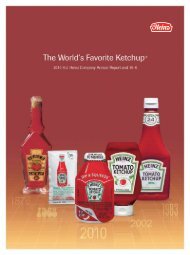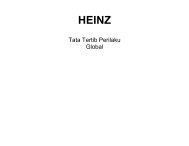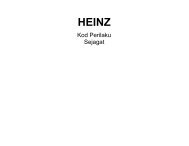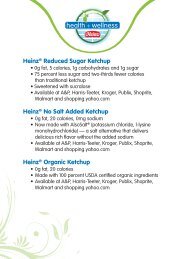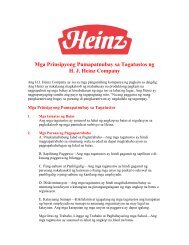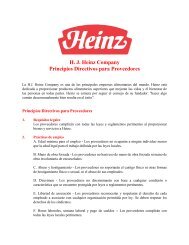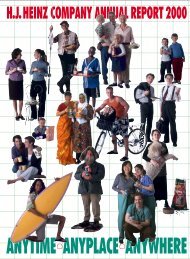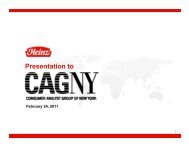Download Annual Report PDF - Heinz
Download Annual Report PDF - Heinz
Download Annual Report PDF - Heinz
You also want an ePaper? Increase the reach of your titles
YUMPU automatically turns print PDFs into web optimized ePapers that Google loves.
exchanged was a non-cash transaction and has been excluded from the consolidated statement of<br />
cash flows for the year ended April 28, 2010. See Note 7 for additional information.<br />
The Company recognized $41.8 million of property, plant and equipment and debt in Fiscal 2010<br />
related to contractual arrangements that contain a lease. These non-cash transactions have been<br />
excluded from the consolidated statement of cash flows for the year ended April 28, 2010.<br />
In addition, the Company acted as servicer for approximately $146 million and $126 million of<br />
trade receivables which were sold to unrelated third parties without recourse as of April 27, 2011 and<br />
April 28, 2010, respectively. These trade receivables are short-term in nature. The proceeds from<br />
these sales are also recognized on the statements of cash flows as a component of operating activities.<br />
The Company has not recorded any servicing assets or liabilities as of April 27, 2011 or April 28,<br />
2010 for the arrangements discussed above because the fair value of these servicing agreements as<br />
well as the fees earned were not material to the financial statements.<br />
9. Employees’ Stock Incentive Plans and Management Incentive Plans<br />
As of April 27, 2011, the Company had outstanding stock option awards, restricted stock units<br />
and restricted stock awards issued pursuant to various shareholder-approved plans and a<br />
shareholder-authorized employee stock purchase plan. The compensation cost related to these<br />
plans recognized in selling, general and administrative expenses, and the related tax benefit was<br />
$32.7 million and $10.4 million for the fiscal year ended April 27, 2011, $33.4 million and<br />
$10.3 million for the fiscal year ended April 28, 2010, and $37.9 million and $12.8 million for the<br />
fiscal year ended April 29, 2009, respectively.<br />
The Company has two plans from which it issued equity based awards, the Fiscal Year 2003<br />
Stock Incentive Plan (the “2003 Plan”), which was approved by shareholders on September 12, 2002,<br />
and the 2000 Stock Option Plan (the “2000 Plan”), which was approved by shareholders on<br />
September 12, 2000 for a ten-year period. The Company’s primary means for issuing equitybased<br />
awards is the 2003 Plan. Pursuant to the 2003 Plan, the Management Development &<br />
Compensation Committee is authorized to grant a maximum of 9.4 million shares for issuance as<br />
restricted stock units or restricted stock. Any available shares may be issued as stock options. The<br />
maximum number of shares that may be granted under this plan is 18.9 million shares. Shares issued<br />
under these plans are sourced from available treasury shares.<br />
Stock Options:<br />
H. J. <strong>Heinz</strong> Company and Subsidiaries<br />
Notes to Consolidated Financial Statements — (Continued)<br />
Stock options generally vest over a period of one to four years after the date of grant. Awards<br />
granted prior to Fiscal 2006 generally had a maximum term of ten years. Beginning in Fiscal 2006,<br />
awards have a maximum term of seven years.<br />
In accordance with their respective plans, stock option awards are forfeited if a holder<br />
voluntarily terminates employment prior to the vesting date. The Company estimates forfeitures<br />
based on an analysis of historical trends updated as discrete new information becomes available and<br />
will be re-evaluated on an annual basis. Compensation cost in any period is at least equal to the<br />
grant-date fair value of the vested portion of an award on that date.<br />
The Company presents all benefits of tax deductions resulting from the exercise of stock-based<br />
compensation as operating cash flows in the consolidated statements of cash flows, except the benefit<br />
of tax deductions in excess of the compensation cost recognized for those options (“excess tax<br />
benefits”) which are classified as financing cash flows. For the fiscal year ended April 27, 2011,<br />
$12.4 million of cash tax benefits was reported as an operating cash inflow and $8.6 million of excess<br />
62





